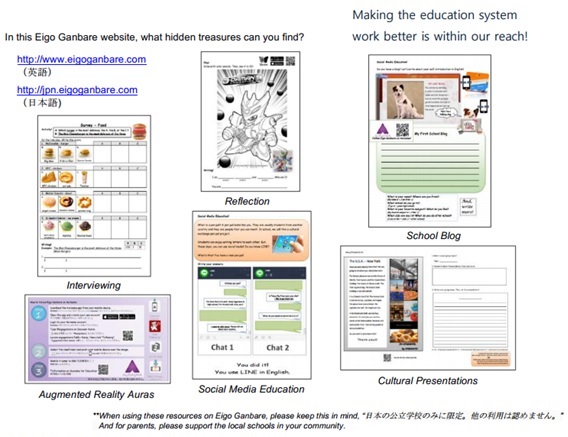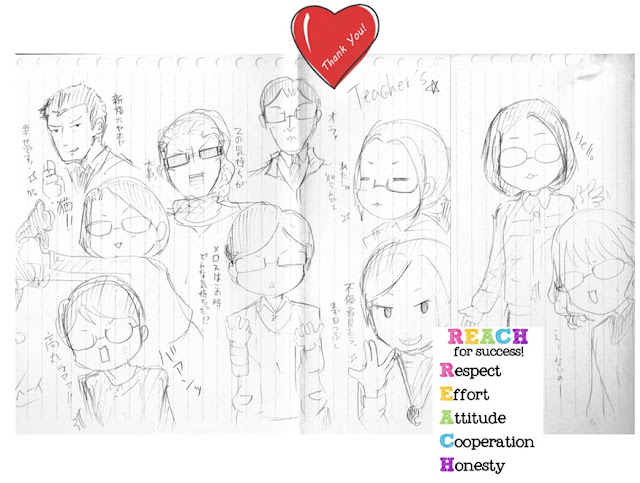Bio: Annette Lee is a veteran ALT who currently works in the Osaka area. She earned a BA in Sociology and Linguistics in 2002 at the University of Washington in Seattle before coming to Japan for the first time after graduating to work as an intern for Sohatsu Systems, an IT company in Kobe. She later applied to the JET Programme and was placed in in a rural town in Hyogo.
After spending a year in the JET Programme, Annette continued to work hard to improve her skills and knowledge. She worked for the dispatch company Interac before returning to the US. She also spent some time as a Sales Assistant for a Seattle based IT company that serves businesses in the US and Japan. Later she returned to Japan to continue her career as an ALT for Interac in Hyogo.
In 2010, Annette launched the beta version of her website, Eigo Ganbare. Drawing on her previous challenges and experience, she made a website for both ALTs and JTEs to get and share resources for teaching English. She researched various team-teaching arrangements in different countries and found that ALTs in Japan lacked the same kind of resources ALTs get in other countries. Annette continues to strive to support ALTs and encourage JTEs in Japan so they can enjoy their work by positively contributing to English education in Japan while gaining a deeper understanding of diversity and what it means to be a global citizen.
As for the future of Eigo Ganbare, Annette is currently working on a classroom portal for teachers and students that uses a combination of traditional and digital material like interactive quizzes. The goal of this portal is to reinforce the information students have learned and allow for further self-study outside of school.
Team-Teaching in English
Native English-speaking Teachers (NETs) in Japanese public schools can be seen as an educational investment, enriching Japanese students to the world outside of Japan and broadening their understanding of mixed ethnic cultures in English-speaking countries. But, how is that possible in a homogeneous country like Japan? Because challenges exist which disrupt the potential of fully implementing an effective team-teaching program in the Japanese English education system. We can, however, set our minds with a positive attitude, take innovative steps with a forward-thinking purpose, and believe that we can achieve success. It begins in incorporating a well-efficient plan with everyone’s cooperation, trust, and belief in one another. With these in place, the flow will proceed smoothly and a vision of a successful team-teaching program can be established in the schools and the communities.
In the mid-1990’s, before I became a NET in Japan years later, I had this rare opportunity to be taught by two high school Japanese language teachers working together in the classroom. One was the lead teacher and the other was the assistant teacher from Japan. I always saw them five days a week and the target language of Japanese was almost always used in every class lesson. I could also learn about Japanese culture/customs. There were opportunities to enter the annual Japanese speech and skit contests because those were class assignments. My school also had a Japanese club with Japan-related outings. Then, in my last year, I met a class of Japanese students from Japan when they visited my school. For that one day, we did group presentations to introduce our country and shared valuable cultural memories with each other. All of these experiences happened in a public school! As for my assistant teachers, I never saw them replaced by another assistant teacher in the middle of the school year and they could stay in the same school for more than a year. Moreover, they were able to have opportunities to make a contribution at my high school, build good relationship with my lead teacher, and become a member of an Association of Teachers of Japanese.
In Japan, the English education curriculum is quite complex and different from the U.S. in how it tailors team-teaching in their schools. Japanese Teachers of English (JTEs) can be assigned as the homeroom class teacher and share their work responsibilities with other subject teachers. These include taking care of the school’s academic scheduling, reports, events, meetings, clubs, and so on. Then, when it comes to their classroom teaching and other English-related responsibilities, their official English textbook curriculum becomes the biggest priority and it carries that influence on to students to mainly focus on passing the entrance examinations. Therefore, the students’ opportunities to benefit from “regular” team-teaching learning with their JTE and NET varies greatly. So, what can be done to properly increase the number of team-teaching lessons in an English class?
First, integrating the NETs into the JTEs’ regular scheduled lesson curriculum would be a good start rather than it being a supplement to team-teaching in English class. Because it helps keep JTEs accountable to fully utilize their NETs, incorporate cultural lesson activities in class, and make the progress of the program grow within the school. If possible, try implementing it on a daily basis, or as close to it, and only schedule NETs with their JTE to multiple schools for “educational outreach” purposes. Find a way to make it work! JTEs and the NET also have to discuss lesson plans, so it’s essential for them to be seated with or within close proximity to each other in the teachers’ room. These NETs aren’t just enthusiastic short-term assistant teachers, but include long-term experienced NETs. There are genuine NETs as well with unique, individualistic, and diverse teaching skills willing to contribute to their school(s) and have hopes to build a trustworthy relationship with school teachers. They give their best effort to work with JTEs, support English-related after school programs, and much more. It is also a good opportunity for all school teachers to learn more about their NETs and acknowledge what they can do in the school to be a productive member. For example, NETs in junior high schools can take part in what other teachers do at work. They can be assigned as the cleaning lead/sub teacher for a group of students to clean the classrooms, be assigned to a color team with work responsibilities on Sports Day, and so on.
In regards to resources, purchasing a district school license for domestic and international teaching materials for the English department in each Japanese school and providing a work laptop for every NET is an investment in providing quality education. The budget for it does exist and it’s possible! For example, funding for Japanese public schools that are given the opportunity with a special subsidized budget to be a “model” school, equipped with hi-tech resources in classrooms and an ICT specialist to train school teachers for a period of time, has already been set aside as a trial. Moreover, those who are in such schools, should take advantage and utilize it efficiently. It’s up to teachers and educators to make wise choices, think of the students’ future, and expand the model program to other schools. Let’s also do this with the English team-teaching program! To do so effectively and efficiently, please see “Goal and Outcome” at http://www.laurasian.org/jleap/index.html and “Benefits” at http://www.laurasian.org/jleap/benefits.html to visualize what a successful team-teaching program is like in the U.S. Then, try to use it as a catalyst to prioritize the quality necessities in the Japanese English education, as well as a way for more Japanese public schools to establish a mutual international connection with public schools abroad.
Over the years, I’ve also been developing teaching resources and putting them on my website, Eigo Ganbare. Many JTEs can only have access to limited, shared teaching resources, and must follow a rigid public school English curriculum. But, if they were provided a balanced workload, teaching flexibility, and a smooth access to resources such as Eigo Ganbare and other educational sites developed by NET/JTE volunteers or licensed English teachers/educators, then they could more confidently enjoy teaching with a purpose and encourage their school to request additional resources to motivate their students. Even NETs who use pre-made lesson plans and activities from external sites can be inspired to create better lessons of their own or with their JTEs.
What is Eigo Ganbare? It originally started out as a message to students that I put on their worksheets because I wanted them to have hope. It means, “ Do your best and stay motivated!” Because no matter how difficult English is, you can do it! Now, it can be a similar message for JTEs to have the spirit of determination to enjoy what they teach, embrace co-teaching with a NET, provide effective JTE/NET team-teaching training to elementary school teachers as English becomes a compulsory course, build confidence to engage new challenges, and respectively support their superiors in making good decisions. 全員参加で楽しくガンバロウ!!
What’s your idea that you “CAN” add in class?
Read more articles, The Pen Pal Project and JHS English Club: Success is Doing.
To learn about another team-teaching philosophy through the eyes of your fellow Japanese, teaching as an ALT in the U.S., please read their essay report at https://www.jflalc.org/jle-j-leap.
For upcoming blogs see the blogs tab here: http://www.alttrainingonline.com/blog.html
– A note from ALT training online’s David Hayter
If you have something ‘ALT’ to write about that hasn’t been covered in these blogs, email David Hayter at: alttoblog@gmail.com so we can work together and spread your story. Don’t have any ideas? ALT training online we have a list of topics to write about that need a writer. Email in your interest to write and we can set you up.
For upcoming blogs see the blogs tab here: http://www.alttrainingonline.com/blog.html
For upcoming blogs see the blogs tab here: http://www.alttrainingonline.com/blog.html
英語のTeam-Teaching
日本の公立学校で英語を母国語とする教師(NETs; Native English-speaking Teachers)は、日本の生徒に海外へ目を向けさせ、英語を話す国々の多様な民族、文化を理解させるという教育目的のもとで、各校に配属されています。しかし、日本のような均一な国家ではそのような目的を達成すること可能でしょうか?なぜなら、効果的なTeam-teachingプログラムを日本の英語教育に持ち込むことは、混乱を招く可能性があるチャレンジングなことだからです。しかしながら、私たちは積極的な態度に気持ちを切り替え、目的のために革新的なステップを踏みながら、成功を達成できると信じています。まずは、お互いに協力し、信頼・信用することから始まります。協力や信頼・信用があれば、スムーズに事が運び、効果的なTeam-teachingプログラムのビジョンが学校やコミュニティの中で確立しやすいでしょう
後に私がNETになる何年も前の1990年代半ばに、私は高校生で、二人の日本語教師に教わるという貴重な機会を持ちました。いずれも日本からきた教師で、一人は指導教員、もう一人は補助教員でした。毎回、教室では、私は週に5回彼らに会い、ほぼ日本語を使用して彼らから日本語を学びました。また、私は日本の文化や習慣についても学びました。また、クラスの課題として、年に一度開催される日本語スピーチあるいは日本語の寸劇のコンテストに参加する機会もありました。私の学校には、日本に関連した課外活動を行う日本クラブもありました。さらに、最終学年の時には、日本から私の学校にやって来た日本人生徒と会う機会もありました。その際には、お互いに自分たちの文化をグループで発表しあい、互い貴重な文化に触れる経験をしました。これらの経験の全部が、公立高校でできたのです!その日本語教育の補助教員は、別の教員と交代させられることは1年の半ばでなく、彼らは少なくとも1年以上は年間をとおして同じ学校に配属されていました。さらに、彼らは、私が通う高校の教育に貢献し、指導教員と良好な関係を築きつつ、日本語の教師の団体のメンバーにもなっていました。
日本における英語教育カリキュラムでは、学校でTeam-teachingをどう組み込むかについて、アメリカと違って非常に複雑です。日本人の英語教師(JTEs; Japanese teachers of English) は、クラス担任として、各科の教師同じように多くの責任を負わなければなりません。それらは、学期やレポート、行事、会議、部活動などにも参加し携わらなければなりません。さらに各クラスでの指導や英語関連の責任を考えた場合、公式の英語教科書が最重要となり、多くの生徒が実際に入試に合格することに主眼を置いていることに影響されてきます。そこで、いかにJTEsとNETsが協力してTeam-teachingを行うかによって、生徒が得る機会は大きく左右されることになります。どうしたら、英語のクラスで、Team-teachingの機会を増やすことができるでしょう?
まず、NETsによる授業を追加のTeam-teachingクラスとするのではなく、JETsが行う通常どおりの英語授業に統合して組み込んでしまうのが良いスタートでしょう。なぜなら、JTEsにとって、文化的な授業を組み込んでより良い授業に発展させるために、NETsを十分に活用できるからです。もし可能ならば、日常からそれを試すかそれに近い形を試してみて、NETsが受け持つ複数の学校のJTEと一緒に行う授業を教育のアウトリーチと位置づけてスケジュールを組んでみましょう。何とか機能するように方法を見つけましょう!JTEsとNETは職員室で近くに座っているのですから、互いにレッスンのプランを話し合わなければならないことは必須です。これらのNETsは、単なる熱心な短期の補助教員ではなく、長期の経験豊富なNETsも含まれます。学校教育に貢献することを真に願い、日本人の教師たちと信頼関係を築きたいと願うユニークで独立して多様な教育スキルを持った本物のNETsはいるのです。彼らは、JTEsとの仕事にベストを尽くし、英語関連の放課後のプログラムも大いにサポートしています。それは、他のすべての教師たちにとって、彼らのNETsを知ってもらい、彼らが学校の有効な教育メンバーの一員と認める良い機会にもなります。例えば、中学校のNETsは他の教師が行う仕事に参加することができます。彼らは、教室の掃除をする生徒のグループの指導教師にもなれますし、運動会の色分けされたチーム責任をもつ担当教師などにもなれるでしょう。
資料については、それぞれの日本の学校の英語科の中で国内や国際的な教育資料を学校の権利で購入し、全てのNETに仕事用のラップトップを提供することは、質の高い教育を提供するために必要な投資でしょう。そのための財源は存在し可能なはずです!例えば、日本の公立学校は、モデル校としてハイテク機材を教室に導入し、ICTのスペシャリストを学校教師の訓練のために一時的に依頼したりするという試みは、特別なモデル校を助成する財源を利用して行われています。さらに、そのようなモデル校は、効果的にその財源や資源を利用する権利があります。教師や教育者の賢い選択により、生徒の未来が変わり、モデルプログラムは他の学校にも広めることができます。これをTeam-teachingプログラムと一緒に進めましょう!効果的かつ効率的に進め、アメリカ合衆国におけるTeam-teachingプログラムの成功例に見られるような、“Goral and Outcome” http://www.laurasian.org/jleap/indes.htmlと “Benefits http://www.larasian.org/jleap/benefits.htmlを目指してください。さらに、それらを日本の公立学校が海外の公立学校との相互の国際交流を確立する助けとなるように用いるだけでなく、日本での英語教育の質を高めるために利用されたらと願います。
何年もかけて、私は教材用の資料を開発して私のウェブサイト Eigo Ganbare. に載せてきました。多くのJTEsにとって、彼らは限られた共用の教材にしかアクセスできず、厳格な公立学校の英語カリキュラムに沿わなければなりません。しかし、もし彼らがもう少しバランスのとれた仕事量と教え方の柔軟性を与えられ、Eigo Ganbareやその他のNET/JTEあるいは資格のある英語教師や教育者が開発した教材をスムーズに取り入れることができたら、彼らはもっと自信を持って目的のある教育を楽しめるでしょうし、生徒のモチベーションを高めるために追加の教材を取り入れるように学校にはたらきかけるようにもなるでしょう。そして、外部サイトから作業やあらかじめ作られたレッスンをそのまま引用して使用していたようなNETsでさえ、彼ら自身であるいはJTEsと一緒に、より良いレッスンを創り出さなければならないと刺激を受けるかもしれません。
Eigo Ganbare は何でしょう? 最初は私が生徒のワークシートに生徒へのメッセージとして彼らに希望を持ってもらいたいと願って書いていたものが始まりです。最善を尽くして、熱意を持って、という意味で。なぜならどんなに英語が難しくても、成し遂げられるからです!今では、JTEsには教えることを楽しむ精神を持ち、NETと互いに教え合うことに取り組み、効果的なJTEとNETによるTeam-teachingプログラムをやがて英語が必修となる小学校の教師に提供し、新しいチャレンジへの自信を築くこと、それぞれの上司が良い決断をするためのサポートにつながるように、同様のメッセージ Eigo Ganbare が多くの人に届くように願っています。全員参加で楽しくガンバロウ!!
このEigo Ganbare のウェブサイトの中には、どんなお宝が隠されているでしょう?
If you have something ‘ALT’ to write about that hasn’t been covered in these blogs, email me at alttoblog@gmail.com so we can work together and spread your story.
Don’t have any ideas? We have a list of topics to write about that need a writer. Email in your interest to write and we can set you up.
Don’t have any ideas? We have a list of topics to write about that need a writer. Email in your interest to write and we can set you up.
For upcoming blogs see the blogs tab here: http://www.alttrainingonline.com/blog.html





